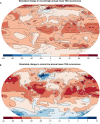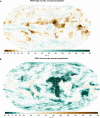Global record-breaking recurrence rates indicate more widespread and intense surface air temperature and precipitation extremes
- PMID: 39514657
- PMCID: PMC11546845
- DOI: 10.1126/sciadv.ado3712
Global record-breaking recurrence rates indicate more widespread and intense surface air temperature and precipitation extremes
Abstract
We analyzed the evolution of extreme annual surface air temperature and rainfall on Earth, based on the recurrence rate of record-breaking events, and found the highest recurrence rates for record-high annual temperatures in the tropics, as opposed to the polar regions with the fastest warming. Both recurrence rates and the global surface area fraction with daily mean surface air temperatures exceeding 30° and 40°C provide further evidence for extremely hot years becoming more common and widespread. A similar analysis for precipitation highlighted some regions with more record-high annual total precipitation and others with record-low annual precipitation typically associated with drought. A multimodel ensemble of 306 runs with global climate models [Coupled Model Intercomparison Project phase 6 (CMIP) Shared Socioeconomic Pathways 2-45 (SSP2-45)] reproduced the statistics of record-breaking high temperatures, but there were some differences for the reanalysis precipitation record-breaking recurrence rates. The global climate model simulations suggested a slightly altered geographical pattern for record-breaking annual precipitation recurrence rates.
Figures





References
-
- Copernicus Climate Change Service, “European State of the Climate Summary 2022” (Tech. Rep., ECMWF, 2023).
-
- Blunden J., Boyer T., Bartow-Gillies E., State of the climate in 2022. Bull. Am. Meteorol. Soc. 104, S1–S516 (2023).
-
- World Meteorological Organization (WMO), State of the Global Climate 2022 (WMO, 2023); https://library.wmo.int/records/item/66214-state-of-the-global-climate-2022.
-
- Qin P., Xie Z., Jia B., Sun S., Characteristics of population exposure to climate extremes from regional to global 1.5°C and 2.0°C warming in CMIP6 models. Environ. Res. Lett. 19, 014018 (2024).
-
- Hu Y., Jia G., Gao H., Li Y., Hou M., Li J., Miao C., Spatial characterization of global heat waves using satellite-based land surface temperature. Int. J. Appl. Earth Obs. Geoinf. 125, 103604 (2023).
LinkOut - more resources
Full Text Sources

